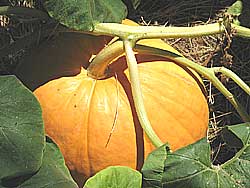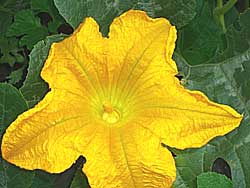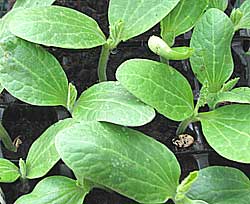Pumpkins - How to Sow and Grow from seed
STORING PUMPKINS
You can store pumpkins for several months
in a dry, airy, frost free place.
Never store pumpkins touching each other - they will rot

EATING PUMPKINS
Pumpkin seeds provide a rich source
of protein and vegetable fats - eat them raw or lightly toasted.
To make Pepitos - fry pumpkin seeds in a little oil and
salt them for a tasty snack.
Try making the Traditional American Pumpkin Pie, sweetened
with brown sugar and spiced with cinnamon.
HOW TO TELL IF A PUMPKIN IS RIPE
The ripe pumpkin has a shiny hard orange skin - you should not be able to pierce the skin with your fingernail.
VEGETABLE PAGES
SOCIETIES
GROWING PUMPKINS
 Pumpkins
are the traditional symbol of the harvest season or perfect for Halloween
jack-o-lanterns.
Pumpkins
are the traditional symbol of the harvest season or perfect for Halloween
jack-o-lanterns.
There are two sorts of pumpkin, Cucurbita pepo and Cucurbita mixta, sometimes known as Cumshaw pumpkin.
Pumpkins are members of the Cucurbitaceae family, and close relatives of marrows. They are all cultivated in the same way.
The type of pumpkin usually grown is Cucurbita Pepo. Bright orange in colour it can grow to enormous sizes - weights up to 78kg have been recorded.
However the ones in your garden will be more like 5kg - pumpkins are not a very sensible choice for a small garden, but a very interesting and unusual alternative to the Vegetable Marrow if you have the space.
BEST CONDITIONS FOR GROWING PUMPKINS
 Pumpkins
are only half hardy plants and will not stand cool conditions.
They will need a long growing season and summer heat to ripen properly.
Pumpkins
are only half hardy plants and will not stand cool conditions.
They will need a long growing season and summer heat to ripen properly.
This means they should be started in a greenhouse or heated frame.
Choose a sunny open site with a rich, well drained soil. In the autumn, dig in plenty of well-rotted compost or manure.
WHEN TO SOW PUMPKINS
Start the pumpkins off in early spring in a heated greenhouse. Sow good quality seed in trays of good quality seed compost or you can sow singly in 7.5cm pots.
GERMINATION OF PUMPKIN SEEDS
The temperature needed for germination is quite high- minimum 21C(70)F
Germination of pumpkin seeds should take one to two weeks.
If you live in a warm part of the country or your garden is very sheltered, you can delay sowing until late spring and sow seed in open ground protected by glass.
Germination of seeds sown outdoors will take longer and the final result not as good as greenhouse sowing because the growing season is shorter.
PLANTING OUT PUMPKIN SEEDLINGS
 Soon after germination the
seedlings will need potting into larger pots 12cm -15cm with a good potting
compost.
Soon after germination the
seedlings will need potting into larger pots 12cm -15cm with a good potting
compost.
When all danger of frost is past you can transplant into open ground in late spring and protect with poly tunnels or glass cloches.
If you live in colder parts then delay planting until early summer.
If you have the room in the garden then plant 1.2 m(4` ) apart in all directions.
Otherwise allow at least 90cm (3 inches). Pumpkins take up a lot of room in proportion to the fruit yield - but with warm weather, and liquid manure you can have a lot of fun growing huge specimens of 10kg or more.
MULCHING PUMPKINS
On the day of planting, mulch the surrounding area with well rotted compost to help retain moisture, keep weeds down and to give a supply of nutrients .
Repeat the mulch in mid-summer and give plenty of water and nutrients at frequent intervals.
CARE OF PUMPKIN PLANTS
Weeds must be kept under control, as they absorb the moisture and nutrients.
Pumpkins have shallow root systems, so be careful not to disturb them when hoeing.
If left to grow untrained a well rooted plant can send out stems 3.5-4.5m(12-15`) long.
That's why it is a good idea to pinch out the growing tips when about two to four pumpkin fruits have formed; this will concentrate growth and control the size of the plant.
PLANTING IN COLDFRAMES
If planting in cold frames it is essential to pinch out the tips.
GROWING PUMPKINS FOR EXHIBITION AND SHOWS
If you want to grow a single pumpkin for a harvest festival or for exhibition, then limit each plant to a single fruit, and feed every week with liquid manure.
If the weather is warm enough you should be able to grow a pumpkin to at least 10kg.
Place a tile or a piece of wood under each pumpkin as it begins to grow to keep them off the ground and prevent them from rotting.
Always allow the pumpkin to ripen on the vine - and always cloche the fruit if a frost threatens.
HARVESTING PUMPKINS
Use a sharp knife to cut the ripe pumpkins, leaving about 7.5cm (3 inches) of stem on the pumpkin.